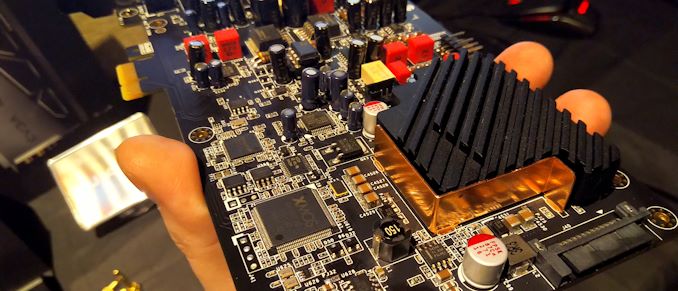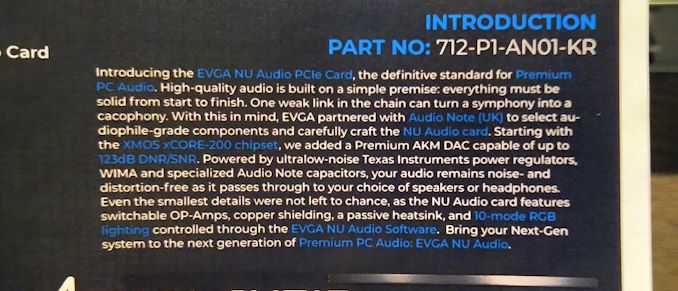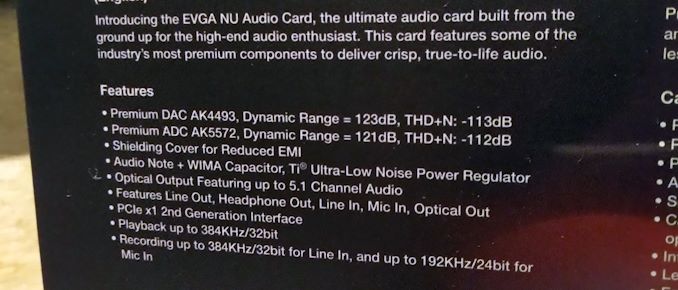EVGA Launches Its First Audio Card, the Nu Audio
by Ian Cutress & Anton Shilov on January 22, 2019 1:00 PM EST- Posted in
- Audio
- EVGA
- Trade Shows
- NU Audio
- CES 2019
- Audio Note

EVGA currently sells a range of products: motherboards, graphics cards, power supplies, cases, and laptops. EVGA has been expanding to other markets for a number of years now, and at CES 2016 we saw the beginnings of a USB audio device due to a collaboration with a professional company called Audio Note. We were impressed at the time, but since then we've not heard much about the project, and had kind of assumed it had been abandoned. But at CES 2019 EVGA introduced the results of the collaboration: its first audio card. This card uses a PCIe to USB controller, making it an internal USB audio product.
EVGA’s Nu Audio card was designed by Audio Note, a UK-based company that develops custom audio solutions. The PCIe 2.0 x1 card implements a PCIe to USB controller to the hardware, and is based on the XMOS xCORE-200 DSP accompanied by Asahi Kasei Microdevices’ (AKM) AK4493 DAC, the AKM AK5572 ADC, and the Cirrus Logic CS5346 ADC. The board uses a silver and gold-plated multilayer PCB with isolated dual ground planes for analogue and digital circuits. Being aimed at users who want a cleaner sound but also better sound support out of their audio outputs, the Nu Audio card uses audio-grade capacitors and resistors that carry Audio Note, Nichicon, WIMA, and Panasonic brands. Besides, it features switchable OP amps as well as a dedicated Maxim amp for headphone volume control.
The Nu Audio card is equipped with two RCA line outs for left and right speakers that can output 384 KHz at 32-bit audio, one output for headphones featuring impedance between 16 and 600 Ohms, an S/PDIF out, a line in supporting 384 KHz at 32-bit audio, and a mic in supporting 192 KHz at 24-bit audio. In addition to traditional analogue and digital outputs, the card supports USB audio class 2.0 enabled by the ASMedia ASM1042 PCIe-to-USB bridge. Meanwhile, to ensure that the board gets enough power, it has a SATA power connector coupled with a multi-stage VRM.
Since EVGA usually targets enthusiasts, its audio card is not only outfitted with a cooling system for heating components, but it is covered by a shroud featuring 10-mode RGB lighting as well as four Audio Reactive Lighting options that match the board’s lighting and audio. The bundled software allows for full EQ tuning, as well as a dynamic response implementation. With the right software, the audio card can support full audiophile formats, such as DSD, and switch between them as required.
EVGA is now currently selling the card, at a price of $249. This is the first in a line of cards, we were told - depending on the feedback of the hardware, the collaboration with Audio Note might extend into a gaming focused design or a more professional audio input/output design.
Related Reading
- EVGA Launches B360 Micro Gaming: Its First Budget Motherboard
- EVGA Releases CLC120 CL11 AIO CPU Cooler: Simple and Affordable
- EVGA Launches SC17 1080 Laptop: Core i7-7820HK, GeForce GTX 1080, TB3
- EVGA Torq X10 Gaming Mouse Review
Source: EVGA
















83 Comments
View All Comments
Qasar - Tuesday, January 22, 2019 - link
" Do people really still buy audio cards? "yep.. cause most onboard audio, doesnt have some of the features an add in soundcard has, unless you are going with a higher end motherboard. all but 1 of my comps i think.. all have soundcards, and on board sound is disabled....
mode_13h - Wednesday, January 23, 2019 - link
Decent onboard audio is certainly possible, but I think it's often an area of cost-cutting for motherboards not aimed at a market where they can charge a premium for it or at least use it as a major selling point.Qasar - Wednesday, January 23, 2019 - link
its.,. but as i mentioned... " higher end motherboard " :-)Krause - Friday, January 25, 2019 - link
And inst it almost impossible to fully shield it if its on the PCI Express bus? I have never encountered an on board audio card that has been immune to having background noise that raised and fell with the load on the graphics card. Not since the original PCI audio card days at least.In almost every way an external USB solution is better, worse is when they try to sell it as a gaming device that will be better than a USB solution, as if games still have native 3d audio processing on an audio cards processor.
Gunbuster - Tuesday, January 22, 2019 - link
Are DPC latency motherboard BIOS and driver issues still a thing? Because if so the last place I want my audio is hanging off a "PCIe to USB controller, making it an internal USB audio product."JoeyJoJo123 - Tuesday, January 22, 2019 - link
It'd be nice if some of these PC audio solutions came with HDMI-audio-only output. For most PC setups that want to route digital surround sound solution (to a a/v receiver with passively powered speakers), the best fidelity is using digital audio passed through HDMI. Digital optical and digital coaxial have limited bandwidth and may not support more than 5 channels of audio (IIRC).Can you route an HDMI port from a video card to a receiver? Yeah, you can, but you can't disable the "hidden" display associated with it (to prevent your mouse from wandering into that display associated with the a/v receiver) without also consequentially disabling the audio source being sent to the receiver. People literally make products to strip an HDMI signal to be audio only, when honestly that feature should be supported for any HDMI solution on a PC...
https://www.monoprice.com/Product?c_id=101&cp_...
I get there's not much output space on the PCI-e slot cover for an HDMI out port, but if we're talking about a high end audio solution for PCs, how many really utilize the line in features? Sending analog audio in (phone/mp3 player?), to amplify it, to send amplified analog audio out? Why wouldn't you just transfer/play the music off the host PC with the sound card?
Same thing with Mic in port. The high quality interfaces for capturing microphone audio (we're assuming if someone has $$$ to buy a high quality soundcard, they likely also have $$$ to buy a high quality microphone) come in the form of USB audio interfaces that can take balanced XLR microphone input and sends that in as a digital signal over a USB bus. There's no real way to get an XLR input on a PCI-e device without making it a 2 slot monster. The other higher quality microphones on the market have an embedded USB interface such as the Blue line microphones (Yeti, Snowball, etc.) or the ATH-2020 USB, etc, so that a user doesn't need to buy a dedicated device for audio interfacing. All-in-all, 3.5mm output microphones on the market are generally not very good, and there's not a whole lot that a high-end soundcard can do to improve microphone quality if the source microphone has poor sensitivity or picks up too much noise.
IMO, i'd rather have high quality audio outputs available (such as hdmi-audio-only output for receivers + surround sound setups) than some audio inputs that wouldn't do a user much good.
darkswordsman17 - Tuesday, January 22, 2019 - link
Because of cost and it being easier to just do HDMI out via video card or your other video device, they're not going to bother with HDMI. They tried that at one point and there were issues with HDCP, so it was often problematic and didn't work well. I'm not sure if any of them ponied up to do Dolby TrueHD or DTS-HD decoding either (I think people thought they were when they were just doing pass through and then analog out of the standard DD/DTS), and certainly none tried Atmos and more recent formats. Would be nice to get a true object based digital audio processor, butWith regards to HDMI, I'd rather have input of it, so that you could capture it and maybe strip out the audio streams, but there's other devices that already do that for reasonable price so that's kinda limited in its appeal for an internal audio card.
I disagree on the mic input. I think it'd still matter. Absolutely the need for that is less due to the prevalence of USB ones, and yeah pro ones will use XLR, and there's plenty of pro digital interfaces to choose from. What they should do is make a USB-C based mic, that has its own ok ADC, but could plug into a USB-C port on a card that features higher end ADC, where they could leverage USB power but would just pass a balanced analog signal when paired with higher quality device. Maybe a wireless mic that could plug in via USB-C for higher quality. And the card have multiple USB-C inputs and work as sound board for say podcasters/streamers.
I think the only meaningful PC audio thing that most people would care about these days though, would be for someone to develop a very high end DSP designed for VR audio, where it would outdo PC software object based audio (but not be locked down like Creative did things that led to them squeezing them out). But it'd basically have to be paired with VR headsets (adding cost to them), or be cheap and open enough that it'd get consumer and developer support. But it could handle things like environment noise cancellation (to help immersion), give a bypass (for people talking to you). And it'd need some neat trick like being paired with some VR audio creation tool that lets you place sound channels where you want them in the 3D space, maybe with some like crazy Fantasia-esque symphonic conductor mode.
mode_13h - Tuesday, January 22, 2019 - link
> I think the only meaningful PC audio thing that most people would care about these days though, would be for someone to develop a very high end DSP designed for VR audio, where it would outdo PC software object based audioMaybe something like this?
https://gpuopen.com/gaming-product/true-audio-next...
https://developer.nvidia.com/vrworks/vrworks-audio
However, offloading noise cancellation to the GPU would almost certainly incur too much latency and jitter.
willis936 - Tuesday, January 22, 2019 - link
These things seem more useful as instruments than for actual audio.Kevin G - Tuesday, January 22, 2019 - link
I'm the crazy one and use an Asus XG-C100C to move up to a 1024 audio channels in and out of my system.As for this card, it appears to be fine high end consumer product but just doesn't seem like a professional card to me. There I'd expect balanced analog IO with similar high quality DACs and perhaps an actual DSP to tackle some of the audio processing. Sure, CPU's are fast enough for production processing but DSP's are useful and beneficial for lowend setups still. Beyond that would be some support for some network audio protocol like Dante or AVB. ASIO drivers are a must for pro usage too.